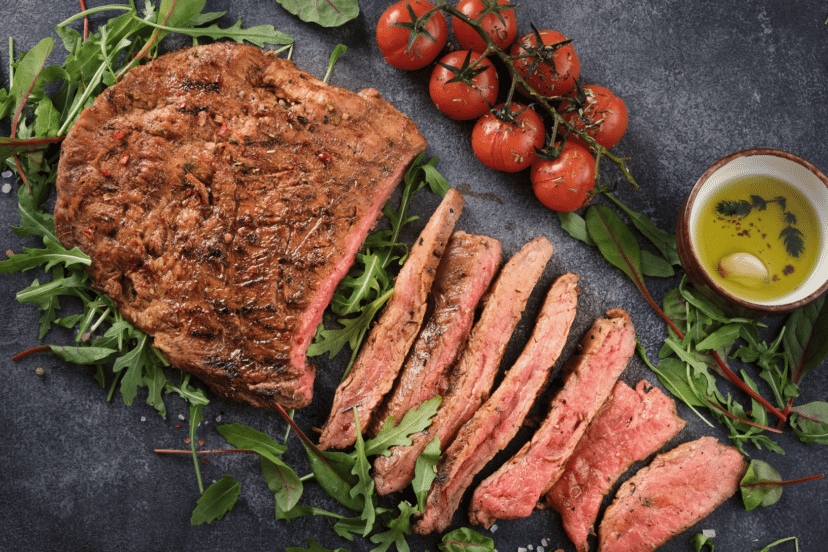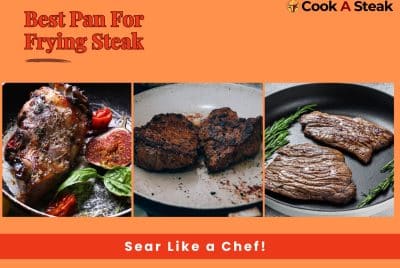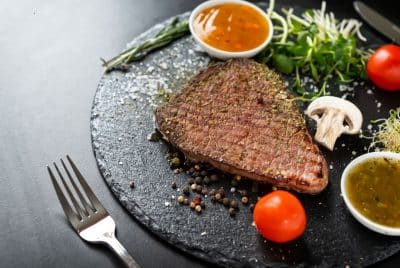Dry-Aged Steak: Fast & Easy Cooking Hacks
Welcome to the exciting world of dry-aged steak—a culinary treat! It’s sure to impress your taste buds and elevate your home-cooking game. Whether you’re a professional chef or a passionate home cook, learning how to cook dry aged steak with a mouthwatering delicacy is an essential skill. It will transform your dining experience!
In this blog post, we’ll guide you through understanding what dry-aged steak is. We’ll talk about choosing the perfect cut, seasoning it just right, selecting the best cooking techniques, etc. The techniques include searing, grilling or reverse searing and finally serving up your delicious creation with some thoughtful beverage pairings.
Table of Contents
- 1 What Is Dry-aged Steak?
- 2 Preparing Your Dry-Aged Steak
- 3 Cooking Techniques For Dry-Aged Steak
- 4 Serving And Pairing Your Dry-Aged Steak
- 5 Tips For The Perfect Dry-Aged Steak Experience
- 5.1 Using A Meat Thermometer
- 5.2 Timing Is Crucial
- 5.3 Allowing The Steak To Rest Before Cutting
- 5.4 Alternative Cooking Methods
- 5.5 How to Cook Dry Aged Steak – Frequently Asked Questions
- 5.6 1. What is dry aged steak?
- 5.7 2. How do you prepare dry aged steak before cooking?
- 5.8 3. What is the best way to cook dry aged steak?
- 5.9 4. Should I season my dry aged steak before cooking?
- 6 Conclusion
Key Takeaways
- Dry – aged steak is beef that aged in a controlled environment for an extended period, resulting in more tender and flavorful meat.
- Choosing the right cut of meat, trimming any excess fat, and properly seasoning before cooking are essential steps to preparing a dry-aged steak.
- Grilling or pan-searing are popular methods for cooking dry-aged steaks. Searing the steak creates a beautiful crust on the outside while keeping it tender and juicy on the inside.
- Resting the cooked steak allows time for juices to redistribute within the meat and ensures it stays moist. Pair with appropriate side dishes and beverages to complete your dining experience.
What Is Dry-aged Steak?
Dry-aged steak is a beef that you store in a controlled environment for a long time. This can be usually between 21 and 120 days. This process not only tenderizes the meat but also enhances its flavor! This is because natural enzymes break down the muscle fibers and proteins over time.
The art of dry aging can be traced back centuries when people discovered that storing meat under specific conditions resulted in improved texture and taste. Today’s modern techniques involve placing the beef cuts in refrigeration units with humidity control, air circulation, and temperature management systems designed to facilitate optimal aging conditions.
In this article, we will talk about the benefits of dry aging and how to cook dry aged steak.
The Benefits Of Dry Aging
Dry aging is a technique used to enhance meat’s flavor, tenderness, and texture. It does so by allowing the meat to rest in special conditions for an extended period. The process involves exposing large cuts of beef, such as ribeye or sirloin, to optimal temperature and humidity levels. This happens in a controlled environment for an extended period.
You can check the benefits of dry aging with just one bite! The steak becomes more complex in taste with a nuttier flavor that you cannot get from fresh-cut beef. Additionally, it becomes significantly more tender as drying leads to increased intramuscular fat (marbling) content. Hence, it results in a buttery finish when cooked correctly.
Different Types Of Dry Aging

There are different types of dry aging methods that can be used when preparing your steak. The most common is the “traditional” method, where the steak is aged in a controlled environment for 21-28 days.
This process allows for natural enzymes to break down and tenderize the meat while also intensifying its flavor. Another method is “wet aging,” where the steak is vacuum-sealed and stored in its juices to retain moisture.
While wet aging is less expensive than traditional dry aging, it doesn’t offer the same depth of flavor or tenderness as longer-aged steaks.
Preparing Your Dry-Aged Steak
To prepare your dry-aged steak, choose the right cut of meat. Then, trim any excess fat, and season it with a generous amount of kosher salt and pepper before cooking.
Choosing The Right Cut Of Meat
When it comes to cooking dry-aged steak, selecting the right cut of meat is crucial for a successful outcome. Some popular cuts include ribeye, striploin, and sirloin. Ribeye is known for its juicy tenderness and rich marbling, while striploin offers a balance between tenderness and flavor.
It’s important to consider the thickness of the cut as well since thicker steak requires longer cooking times. Additionally, look for well-marbled beef with visible fat throughout the meat as it adds moisture and enhances flavor during the dry aging process.
Preparing The Steak For Cooking
Before cooking your dry-aged steak, you need to prepare it properly. When learning how to cook dry aged steak, following the steps is essential. So, follow these steps for the best results:
- Choose a high-quality cut of dry-aged steak based on your preference and budget.
- Remove the steak from its packaging and pat it dry with paper towels to remove excess moisture.
- Let the steak sit at room temperature for up to an hour to ensure even cooking.
- Trim any excess fat or silver skin from the edges of the steak using a sharp knife.
- Score the fat cap of the steak in a crosshatch pattern to prevent it from curling up during cooking.
- Season both sides of the steak generously with kosher salt and freshly ground black pepper, or your preferred seasoning blend.
- Rub oil onto both sides of the steak to help prevent sticking and promote browning.
- Let the seasoned and oiled steak rest for at least 10 minutes before cooking to allow the seasoning to penetrate into the meat.
By following these simple steps, you can ensure that your dry-age steak is good and ready for cooking. This results in delicious and perfectly seasoned meat every time.
Seasoning The Steak
To bring out the best flavors in your dry-aged steak, proper seasoning is crucial. The most essential thing to remember when seasoning a steak is to keep it simple and let the meat’s natural flavor shine through.
Before cooking, ensure that both sides of your dry-aged steak are evenly coated with salt. Allow the seasoned steak to rest at room temperature before you start grilling or pan-searing.
While some may add additional seasonings like garlic, rosemary, or thyme, we recommend keeping things minimalistic by using only salt and pepper so as not to overpower the delicious flavors of the beef.
Cooking Techniques For Dry-Aged Steak

Choose the right cooking method, whether it’s grilling or pan-searing, and prepare your equipment accordingly.
Selecting The Right Cooking Method
Choosing the right cooking method for your dry-aged steak is essential in achieving the perfect texture and flavor. While there are several options available, each one has its own unique set of benefits and drawbacks.
Grilling is a popular choice that allows you to obtain the unmistakable smokey flavor while creating beautiful grill marks on your steak. Pan-searing is another great option that can help you achieve a crisp crust with a juicy, tender inside.
For those who want a more hands-off approach, sous vide cooking provides an excellent way to slowly cook your steak at a low temperature before finishing it off with high heat to create a caramelized exterior. So, before learning how to cook dry aged steak, discover the right method.
Preparing The Grill Or Pan
Before cooking your dry-aged steak, it’s essential to prepare the grill or pan properly. This ensures that the heat is evenly distributed, and your steak cooks to perfection. Here are some steps to follow:
- Preheat your grill or pan: Make sure your grill or pan is heated up before placing the steak on it. The ideal temperature for grilling a dry-aged steak is between 450-500°F.
- Oil the grill or pan: Use a neutral oil like canola, grapeseed, or vegetable oil to coat the surface of the grill or pan. It will help prevent sticking and provide a non-stick surface.
- Clean the grill or pan: Scrub off any leftover residue from previous use with a brush or cloth. This step ensures no old food debris affects the taste of your steak.
- Season the grill or pan: Generously season the surface of your grill or pan with kosher salt and pepper before placing your steak on it.
By following these simple steps, you’ll have a perfectly prepared surface for cooking your dry-aged steak to perfection!
Searing The Steak
Searing the dry-aged steak is where the magic happens. This technique locks in all of the flavor and creates a beautiful crust on the outside while keeping it tender and juicy on the inside.
To do this, you’ll want to heat up your cast-iron skillet until it’s smoking hot. Carefully place your seasoned dry-aged steak onto the pan and let it sear for 2-3 minutes per side without moving it around too much.
If you’re grilling your steak instead, be sure to make sure that both sides are evenly coated with oil or butter before placing them on a preheated grill grate over high heat.
Leave them there undisturbed for about two minutes per side to achieve those classic grill marks we all crave. Once both sides have been seared, lower the heat to medium-rare and cook for another 6-8 minutes (depending on your desired doneness) before removing from heat.
Cooking To The Desired Level Of Doneness
Knowing how to cook your dry-aged steak to the perfect level of doneness is crucial for achieving that melt-in-your-mouth experience. The easiest way to check for doneness is by using a meat thermometer, which should be inserted into the thickest part of the steak.
For medium-rare steak, aim for an internal temperature of 130-135°F (54-57°C) and for medium, aim for 140-145°F (60-63°C).
However, if you prefer not to use a meat thermometer or want an alternative indicator of doneness, you can use touch and sight. Using your finger or tongs, lightly press on the center of the steak – it should feel soft and springy if cooked rare or medium-rare; slightly firm but still yielding with some resistance when cooked through at medium; and firm with almost no give when well done.
Serving And Pairing Your Dry-Aged Steak

After you know how to cook dry aged steak to perfection, it’s time to serve and pair it with the right side dishes and beverages for a complete dining experience.
Resting The Steak
After cooking your dry-aged steak, it’s essential to give it a little time to rest before cutting into it. Resting allows the juices to redistribute in the meat and ensures that they don’t all run out when you slice into it, resulting in a drier cut of meat.
As a general rule of thumb, let your steak rest for about 5-10 minutes before cutting.
During this resting period, cover your dry-aged steak with aluminum foil or place it on a warm plate to keep it from cooling too quickly. This will also allow the internal temperature of the meat to continue rising slightly as residual heat moves towards its center.
Remember always to use an instant-read thermometer after resting –once ready–to ensure that the desired level of doneness has been achieved internally based on its thickness and weight according to FDA guidelines.
Slicing And Plating
After allowing the dry-aged steak to rest for a few minutes, it’s time to slice and plate. Here are some tips:
- Use a sharp knife for slicing the steak into thin pieces against the grain.
- Arrange the slices on a plate with any desired side dishes.
- Drizzle the meat with a little bit of olive oil or melted butter for added flavor and moisture.
- Optional: sprinkle chopped fresh herbs on top, such as thyme or rosemary.
- Serve immediately while still warm.
Remember that presentation is key when plating your dry-aged steak. Take time to arrange the meat and sides attractively on the plate. And don’t forget to pair with your preferred wine or beverage based on the flavors of your dish.
Choosing The Perfect Side Dishes
When it comes to serving your dry-aged steak, choosing the perfect side dishes is just as important as cooking the steak itself. Here are some suggestions for side dishes that complement the rich flavor of dry-aged steak:
- Roasted vegetables: Roasting vegetables bring out their natural sweetness and adds a bit of texture that complements the meatiness of the dry-aged steak.
- Creamed spinach: This classic side dish pairs perfectly with a juicy steak and adds a touch of elegance to your meal.
- Grilled Corn on the Cob: Grilling sweet corn on the cob is an excellent way to add color and crunch to your dinner plate and complements the smoky flavor of grilled meats.
- Baked Potatoes: A classic companion for steak dinners, these potatoes can be served plain or topped with herbs, butter, or cheese to satisfy even picky eaters.
- Mushroom Risotto: The earthy flavors of mushroom risotto make it a favorite among foodies and pairs nicely with a glass of red wine and dry-aged beef.
Remember, sides should not overpower your main course but rather complement its flavors. Be creative with your choices, experiment with different seasonings, and enjoy!
Pairing With The Right Wine Or Beverage
Choosing the right wine or beverage to accompany your dry-aged steak is just as important as selecting the perfect cut of meat. A full-bodied red wine, such as Cabernet Sauvignon or Malbec, pairs well with a juicy and flavorful dry-aged steak.
If you do not like red wine, try a bold beer like an IPA or stout.
When it comes to pairing wine with beef, tannins are key. Aged steaks contain higher levels of fat and marbling than fresh meats which can make them quite fatty in texture and taste.
This richness works well when paired with wines that have strong tannins that can help balance out the flavor profile of the dish.
Tips For The Perfect Dry-Aged Steak Experience
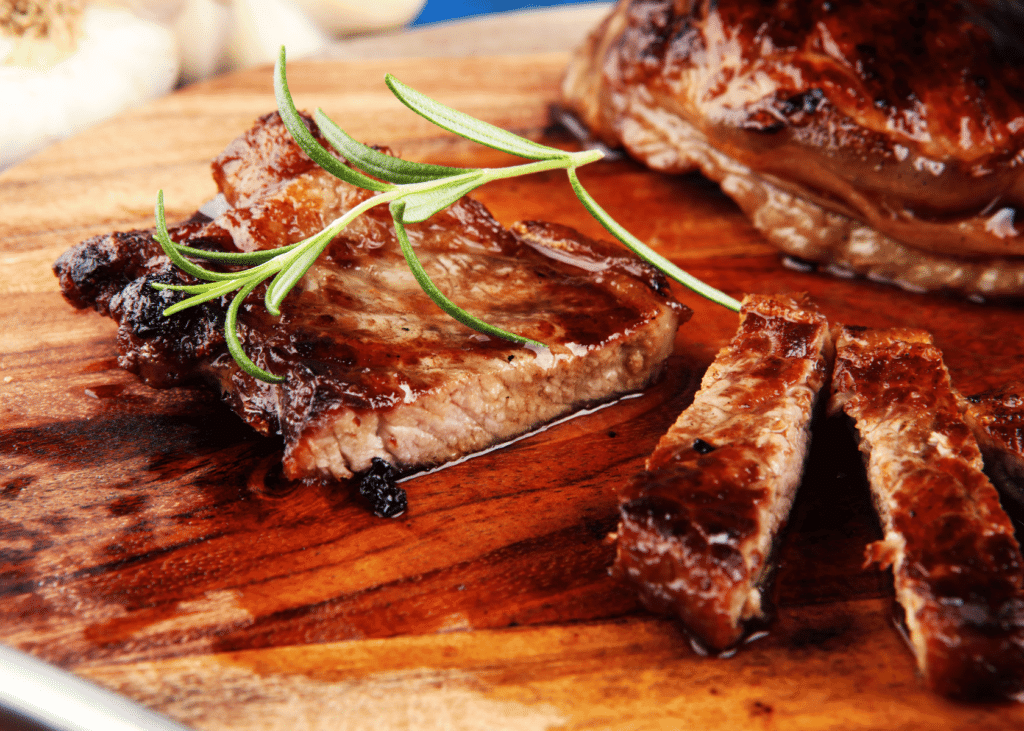
– Use a meat thermometer to ensure the steak is cooked to your desired level of doneness.
– Timing is crucial, so make sure you are aware of the cooking time for your specific cut of meat and chosen method of cooking.
– Allow the steak to rest before cutting into it, allowing the juices to redistribute throughout the meat.
– Consider alternative cooking methods such as sous vide or oven baking for a unique and delicious experience.
– Trimming excess fat from your dry-aged steak can help prevent flare-ups during grilling and promote even cooking.
– Experiment with different seasonings and marinades to find your perfect flavor profile!
Using A Meat Thermometer
One of the most crucial steps in learning how to cook dry aged steak and achieving a perfectly cooked dry-aged steak is using a meat thermometer. This tool ensures that you cook your meat to the correct temperature, which can make all the difference between a tender and juicy steak and an overcooked one.
Start by inserting the thermometer into the thickest part of your steak, making sure that it’s not touching any bone or gristle. For medium-rare doneness, aim for an internal temperature of 130°F (54°C).
Remember to remove your steak from heat when it reaches about five degrees below your desired temperature as it continues cooking while resting.
Timing Is Crucial
Timing is everything when cooking a dry-aged steak to perfection. Whether you prefer your steak rare, medium-rare or well-done, getting the timing right is critical. For example, if you’re grilling a 1-inch thick ribeye steak to a medium-rare doneness level on high heat, it should take approximately four minutes per side for the meat’s interior temperature to reach around 135-140°F.
If you leave it too long on the grill, it will become overcooked and lose its tenderness and juiciness. Moreover, resting the steak for several minutes after removing it from heat allows time for juices within the meat to redistribute evenly throughout before slicing into it and enjoying its delicious flavor and texture.
Allowing The Steak To Rest Before Cutting
Properly resting your dry-aged steak before cutting it is essential in ensuring maximum flavor and tenderness. This process allows the juices to redistribute throughout the meat, resulting in a more succulent and moist taste.
Ideally, you should let your steak rest for about 5-10 minutes before slicing it up.
However, keep in mind that this resting period may vary depending on the size of your cut of meat. For instance, larger steaks may require up to 15 minutes of resting time whereas smaller cuts can be served immediately after cooking.
If you slice into your steak prematurely, you risk losing those precious juices and ending up with tough and dry results.
Alternative Cooking Methods
If you’re looking to cook your dry-aged steak using an alternative method, there are several options available. One popular method is sous vide cooking, where the steak is vacuum-sealed in plastic and cooked slowly in a water bath at a low temperature.
Another option is oven-baking, which involves placing the steak on a wire rack over a baking sheet and cooking it until it reaches the desired level of doneness.
Finally, reverse searing is gaining popularity among chefs as an innovative way to cook steaks. This involves slowly bringing the internal temperature up to about 10-15 degrees below your desired level of doneness before quickly searing it on high heat to finish.
How to Cook Dry Aged Steak – Frequently Asked Questions
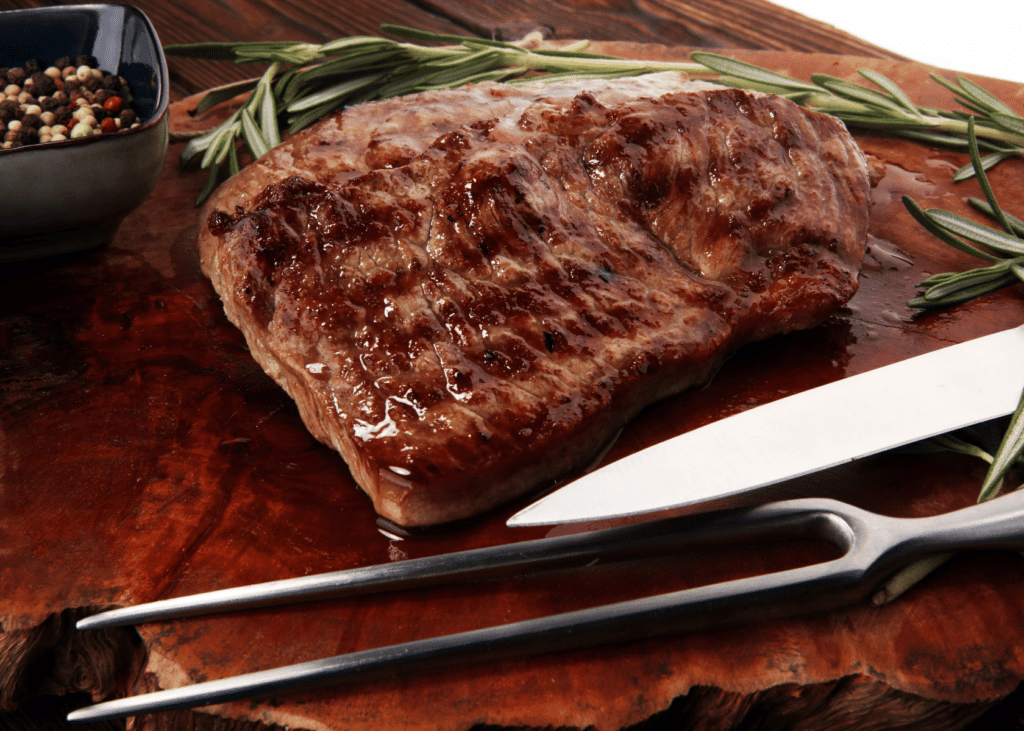
1. What is dry aged steak?
Dry aged steak is a cut of beef that has been hung and exposed to air for several weeks in a temperature-controlled environment. This process helps enhance the flavor and tenderness of the meat by allowing natural enzymes to break down muscle fibers.
2. How do you prepare dry aged steak before cooking?
Before cooking, remove any excess moisture from the surface of the steak with a paper towel and let it sit at room temperature for about an hour. This will help ensure even cooking and prevent the meat from becoming tough or overcooked on the outside.
3. What is the best way to cook dry aged steak?
The best way to cook a dry aged steak depends on personal preference, but most people recommend using high heat methods such as grilling or searing on a cast iron skillet for maximum flavor retention. Cook until internal temperature reaches desired level, between 120-160°F depending upon preferred doneness.
4. Should I season my dry aged steak before cooking?
Yes! Seasoning your dry-aged steaks ahead of time allows salt & pepper (or favorite spices) time infuse into their fibers while adding additional flavor layers onto them which can really make all difference when done right! Remember – only use enough seasoning so that you can still taste quality beef without overpowering its natural flavors; too much salt could leave some diners disinterested in finished product.
Conclusion
Cooking a perfect dry-aged steak might seem daunting, but with the right method and careful attention to detail, you can get it just right. Remember to choose the right cut of meat, season it well, and cook it using your preferred method.
Whether grilling or pan-searing, make sure that the cooking temperature is high enough to get that beautiful caramelization on both sides. And when serving your perfectly cooked steak, be sure to pair it with the perfect wine or beverage and side dishes for an unforgettable meal.
*We may earn a commission for the purchases made using our links. Please see our disclosure to learn more.

